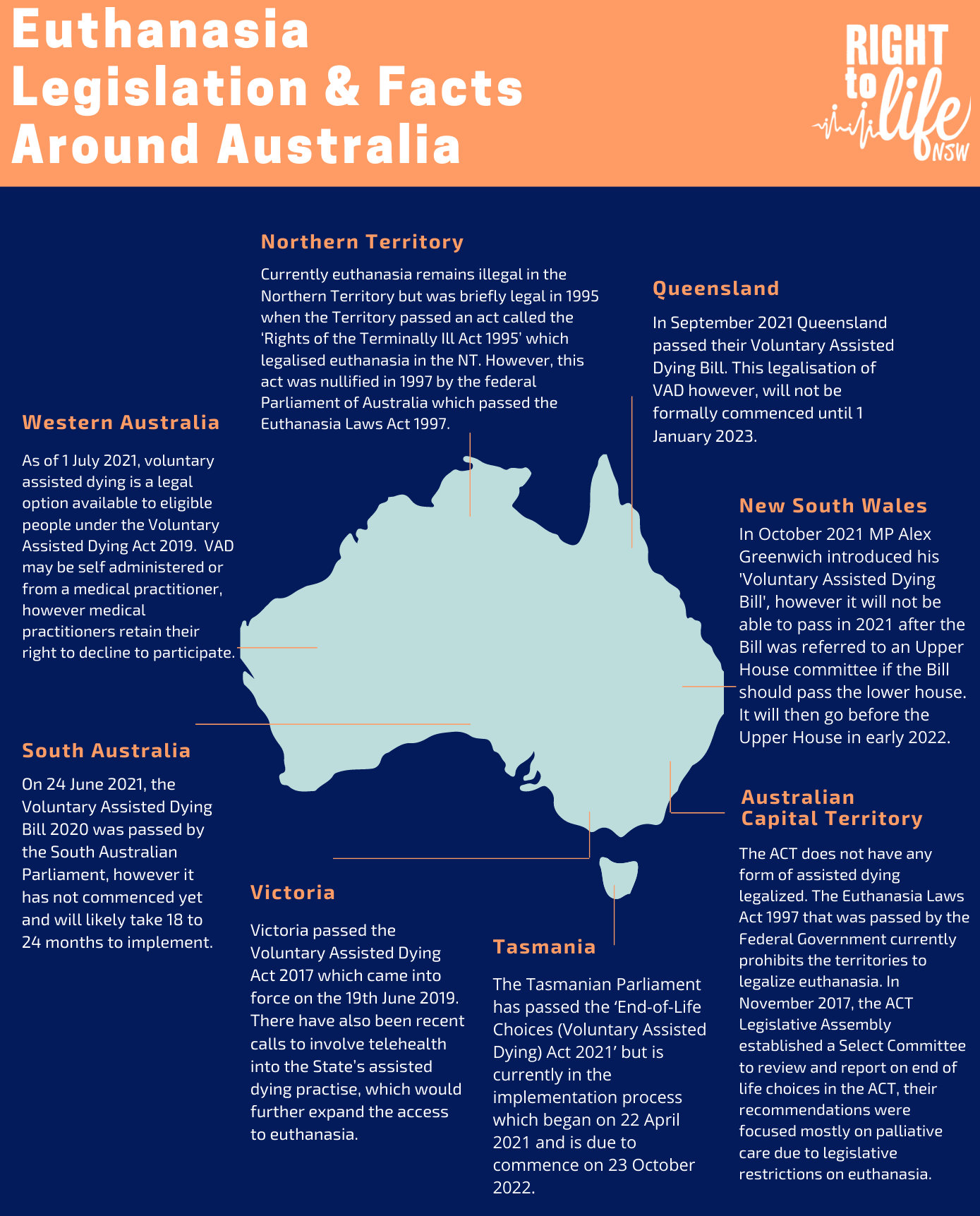 DEATH IS FOREVER. THERE IS NO UN-DOING IT.
DEATH IS FOREVER. THERE IS NO UN-DOING IT.
We’ve all heard the saying, “if it’s too good to be true, it usually is.” That’s exactly the problem with euthanasia. Those in favour would argue that it gives someone who is terminally ill, or someone who is suffering, the chance to end their lives on their terms – to not have to endure any more suffering.
When you get past that initial, emotional argument for euthanasia, the practice of helping someone end their life opens the door to some dangerous possibilities. At issue, the sanctity of life, the care of our terminally ill, and the troubling future of how it will lead to more assisted suicides of people who aren’t suffering pain from a terminal illness.
Accepting euthanasia accepts that some lives are worth less than others. Right to Life NSW believes that accepting “voluntary” euthanasia will eventually lead to “involuntary” euthanasia, and the killing of people thought to be undesirable.
We believe accepting euthanasia could lead to less quality care for the terminally ill by undermining the motivation to provide good care or pain relief for the dying. It might become a more “cost effective” way to treat the dying. It also puts doctors and nurses in a difficult position. These are people who are committed to saving lives.
Finally, it is already clear where there are laws allowing euthanasia, the number of people seeking assisted suicides is growing at alarming rate. Also, some of the people seeking out these assisted suicides aren’t people who are dying or in pain. Rather, they are just aged, alone or bereaved.
A terminally ill person is someone who is vulnerable. As a society, we must protect the vulnerable – not kill them. If for no other reason, if we’re wrong, when it comes to that person’s life and death, there’s no going back.
TYPES
DISTINGUISHING THE DIFFERENT TYPES OF EUTHANASIA
- DIRECT OR ACTIVE EUTHANASIA – when action is taken to hasten a person’s death. These include physician-assisted suicide, or any of a number of methods taken by someone else to help a person die.
- PASSIVE EUTHANASIA – when action is withheld for the purpose of hastening a person’s death. These include withholding or withdrawing things like medicine, food, water or oxygen.
- VOLUNTARY EUTHANASIA – conducted with the consent of a patient.
- NON-VOLUNTARY EUTHANASIA – conducted where the consent of the patient isn’t available.
- INVOLUNTARY EUTHANASIA – conducted against the will of the patient.
LAW
THE LAW

- In New South Wales, both euthanasia and physician-assisted suicide currently carry heavy penalties under criminal law. Under the NSW Crimes Act 1900, a person found guilty of engaging in active voluntary euthanasia could be convicted of murder and face in life in prison. Also, a person aiding or abetting the suicide of another person could face up to 10 years in prison.
However, there have been recent pushes to introduce legislation in New South Wales. In October 2021, a bill was introduced in the NSW Legislative Assembly by MP Alex Greenwich that would allow voluntary assisted dying.
Countries like the Netherlands, Belgium, Luxembourg, Switzerland, Estonia, Albania, the U.S. states of Montana, Oregon, Vermont and Washington, and the Canadian Province of Quebec have laws in place making assisted suicide legal. Great Britain is considering one.
EFFECTS
THE EFFECTS OF EUTHANASIA
- On the Terminally Ill: A patient with terminal illness is vulnerable. He or she may lack the knowledge to deal with the pain or other symptoms being experienced. There may be fear or anxiety about the effect his or her illness is having on loved ones. Their decision-making may be affected by their symptoms, by dementia or confusion. They may be saying, “let me die.” But after effective symptom relief and/or counselling, they are usually grateful their request was not acted upon on. The way we treat the weakest and most vulnerable people speaks to the kind of society we are.
- On the Family or Carers of the Terminally Ill: No person makes the decision for euthanasia alone. There are others involved – family or close friends. They are put in a difficult position involving that person’s life or death, and may experience guilt, anger or bitterness after the person dies. The decision to end a life may have a profound effect on them for years to come, and may affect others outside the decision-making process as well.
- On Medical Professionals: A doctor’s role is to save lives, not end them. Physician-assisted suicide undermines that role, as well as hurt the trust and confidence a patient may have in his or her doctor.
- On Medical Research: There have been dramatic medical advances over the last century, to seek treatments for diseases considered ‘untreatable.’ The same can be said for the management of a person’s pain and suffering, both physically and psychologically. When the focus changes from curing the condition to killing the person with the condition, that whole process is threatened. Taking it a step further, we will see advances in the ‘science of killing,’ at the expense of saving lives.
IMPACT
EUTHANASIA WON’T STOP WITH THE TERMINALLY ILL
- A man who helped lead the push for Euthanasia in the Netherlands admits he was “dead wrong” and warns other countries “not to go there.” He says there has been an alarming increase in assisted suicides in his country, and says euthanasia is now extending beyond the terminally ill who are suffering.
- http://alexschadenberg.blogspot.com.au/2014/07/dutch-ethicist-assisted-suicide-dont-go.html
 Right to Life NSW
Right to Life NSW